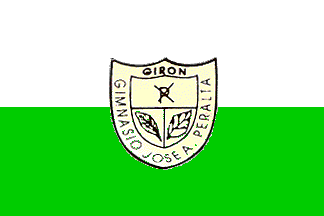 image by Ivan Sache, 10 January 2004
image by Ivan Sache, 10 January 2004
Last modified: 2024-02-24 by rob raeside
Keywords: education |
Links: FOTW homepage |
search |
disclaimer and copyright |
write us |
mirrors
See also:
 image by Ivan Sache, 10 January 2004
image by Ivan Sache, 10 January 2004
The College is located in Giron, Santander department. Its
flag is horizontally divided yellow-green with the College emblem
in the middle.
Source: www.voluntad.com.co,
located by Dov Gutterman.
Ivan Sache, 10 January 2004
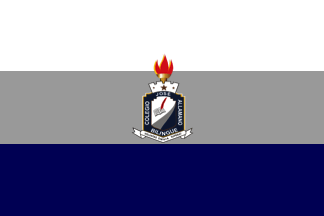 image by Ivan Sache, 11 December 2020
image by Ivan Sache, 11 December 2020
Colegio Bilingüe José Allamano was established on 10 February 1962 in borough
San Gabriel de Bogotá, by Father Juan Fiorina, as Colegio Parroquial Los Doce
Apostóles. The school was renamed to Colegio José Allamano, and to Colegio
Bilingüe José Allamano by Resolution No. 160,028 issued on 3 September 2012.
Giuseppe Allamano (1851-1926; blessed on 7 October 1990 by Pope John Paul II)
established the Consolata Missionaries on 29 January 1901 and the Consolata
Missionary Sisters on 29 January 1910.
https://www.colegioallamano.edu.co
School's website
The flag of Colegio Bilingüe José Allamano is
horizontally divided white-grey-blue with the school's coat of arms in the
center.
White means purity, peace, kindness, harmony and transparency in
the process of pedagogic teaching offered by the school. It also represents the
student's project of life.
Gray represents discipline, commitment to study,
knowledge and respect in the process of pedagogic teaching with students.
Blue of the seas uniting continents represents international and intercultural
opening. It also represents responsibility, compromise, transcendence and
projection in the process of pedagogic teaching of the institution.
On
the coat or arms:
1. The flames burning from the torch represents the Father,
the Son and the Holy Spirit, as a spiritual force boosting the process of
pedagogic teaching of the school.
2. The stars represents the school's Marian
dimension, under the advocation of the Consolata Virgin and refers to the three
stars featured on the Virgin's cloak. They also represent the institution's
ideals and goals in the process of pedagogic teaching with students.
3. The
book and quill represents knowledge and wisdom as the institution's pedagogic
means.
4. The school's flag featured in the shield's inner part has the
aforementioned meaning.
5. The scroll is inscribed with the Latin motto
"VOLUNTAS OMNIA SUPERAT" (Willingness Triumphs Over Everything).
https://www.colegioallamano.edu.co/institucion
School's website
Ivan Sache, 11 December 2020
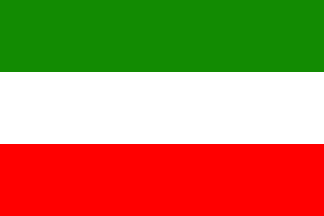 image by Ivan Sache, 24 January 2019
image by Ivan Sache, 24 January 2019
Institución Educativa José Antonio Galán, located in La Tableza, La Estralla
(Antioquia Department), is composed of four seats, José Antonio Galán, Atanasio
Girardot, Tulio Ospina and La Inmaculada.
The flag of IE José Antonio
Galán is prescribed in Article 7 of the Manual de Convivencia, as horizontally
divided green-white-red. Green represents hope, friendship and service. White
represents purity, integrity and firmness. Red represents force, triumph and
audacity.
https://www.jaga.edu.co/phocadownload/Documentos/2017/ManualConvivenciaCompleto.pdf,
Manual de Convivencia
Ivan Sache, 24 January 2019
 image by Ivan Sache, 24 January 2019
image by Ivan Sache, 24 January 2019
Institución Educativa José Antonio Galán is located in San Bernardo
(Cundinamarca Department). The school is named for José Antonio Galán
(1749-1783), leader of the Commoners insurrection in Santander (1781-1782).
Captured on 13 October 1781 in Chaguanete, near Onzaga, Galán was brought to
Socorro; sentenced to death on 30 January 1782, he was executed the next day.
The flag of IE José Antonio Galán is composed of three colored stripes of
equal size, placed horizontally as follows:
Celestial blue: Represents water
resources as the source of life and the school's compromise to preserve and
conserve it through promotion of ecological awareness in the educational
community.
White: Represents the promotion of culture and peace through an
healthy coexistence and the respect and defense of human rights.
Green:
Represents the aspiration to a better future based on the protection of natural
environment as a vital axis of survival.
http://iejoseantonigalan.blogspot.com/2010/07/simbolos-de-la-institucion.html,
School blog
Ivan Sache, 24 January 2019
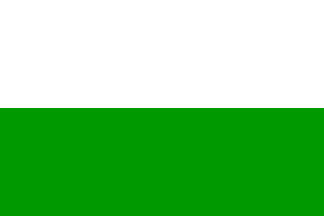 image by Ivan Sache, 13 January 2009
image by Ivan Sache, 13 January 2009
"Colegio de Educación Básica y Media Técnica 'José
Benigno Perilla'", founded in Somondoco (Department of
Boyacá) by María Lidia Puentes González (b. 1939), was
recognized on 10 August 1962 by the Department of Boyacá (Decree
No. 546), as "Escuela Normal Superior Femenina 'José
Benigno Perilla' de Somondoco". The institute is named after
José Benigo Perilla (1831-1893), second Archbishop of Tunja
(1887-1893).
The flag of the institute is shown graphically on the website of the
institute, as horizontally divided white-green with the
emblem of the institute in the middle. White means purity while
green means hope. The written description does not mention the
emblem; moreover, the flag is said to have been officially
approved in 1970 whereas the emblem was designed in 1981.
Therefore I believe that the flag actually used is without the
emblem.
The emblem of the institute was designed in 1981 by student
Abraham Sánchez Sánchez. The shield is divided into four
concave quarters by a red cross. The upper left quarter shows a
white open book on a green field. The upper right quarter shows a
red quill and inkpot on a hwite field. The lower left quarter
shows a red torch on a white field. The lower right quarter shows
a white diploma on a green field. A white escutcheon charged with
a green pair of scales is placed in the middle of the shield. The
shield is topped by a golden mural crown. The green
writing "Colegio de Educación Básica y Media
Técnica José Benigno Perilla Somondoco Boyacá" is placed
on a scroll under the shield. The cross recalls the cultural
heritage and, especially, His Grace José Benigno Perilla; red
symbolizes the sacrifice and constancy expected form the
students. The book is the symbol of science, culture and work.
The quill and inkpot symbolize empowerment, commitment and
creativity. The torch is the symbol of knowledge and eternal
spiritual light. The diploma symbolizes abnegation and great
expectations. White and green are taken from the flag of the
institute. The pair of scales represents commerce. The mural crown
represents integrity, firmness and education expected to form a
fortress. Gold is the symbol of obedience.
Ivan Sache, 13 January 2009
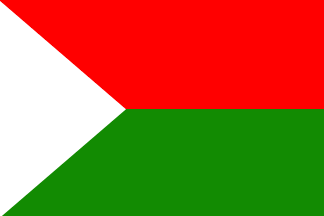 image by Ivan Sache, 12 December 2020
image by Ivan Sache, 12 December 2020
Colegio Jose Celestino Mutis is based in borough Mutis, Bucaramanga
(Santander).
The flag of Colegio Jose Celestino Mutis is horizontally
divided red-green with a white triangle placed along the hoist.
Green
represents youth's loyalty, hope, vigor and vivacity, as well as natural
environment and fruit of the soil.
Red represents people's love, glee,
felicity, friendship and heroism. Red is the color of great leaders.
White
represents purity, honesty, innocence and peace.
The combination of the
red, green and white colors produces harmony, representing love, science,
success, honesty and peace. These re the colors of welfare.
http://colegiojosecelestinomutis.edu.co/index.php/page/item/9
School
website
Ivan Sache, 12 December 2020
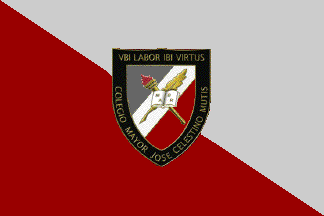 image by Ivan Sache, 13 March 2017
image by Ivan Sache, 13 March 2017
Colegio Mayor José Celestino Mutis was established in November 1950 by Dr.
Manuel Antonio Bernal Ramírez (1917-1982) and his wife, Blanca Sánchez de
Bernal.
The institute is named for the botanist José Celestino Mutis
(1732-1808). After graduation at the Royal Surgery College in Cádiz, Mutis was
hired in 1760 as his personal doctor by Pedro Messia de la Zerda, Vice-Roy of
New Granada. A brilliant scholar, he was appointed in 1762 Lecturer in
Mathematics at the Colegio del Rosario (today, the University of Bogotá). From
1766 to 1766, Mutis explored the provinces of Pamplona and Ibagué to established
silver mines; he was appointed in 1777 manager of the El Sapo mine in Ibagué.
Mutis' main interest, however, was in natural history. The request of funding a
scientific expedition submitted to Charles III in 1763 and reiterated next year
remained unanswered. Not discouraged, Mutis had to wait for 20 years: on 29
April, the court initiated the "Royal botanical expedition in the Kingdom of New
Granada", with the support of Vice-Roy Antonio Caballero y Góngora. The royal
approval of the expedition increased the fame of Mutis among botanists; he was
elected member of the Academy of Sciences of Stockholm, corresponding member of
the Royal Garden in Madrid, and member of the Royal Academy of Medicine. The
court acknowledged his records and proposals of use of plants from New Granada
for healing purpose. In an expedition made in 1772 with Pedro Ugarte, Mutis
discovered cinchona trees in Sierra de Tena; he promoted the extraction and
export of quinine, especially in the article "Arcano de la Quina" (The Secrete
of Quinine), published in May 1792 in the Santa Fé de Bogotá gazette.
Mutis' expeditions and research were not aimed at increasing the benefits of
the court but at boosting the cultural and economical development of New
Granada. He was involved in the establishment of the Sociedad Patriótica de
Nuevo Reino de Granada (1801) and the creation of the astronomical observatory
of Santa Fé de Bogotá (1803), in strong opposition with the Spanish courtesans
led by Gómez Ortega. Mutis expected his collections and papers to remain in New
Granada for the sake of progress and education; the political unrest, however,
prompted the shipping of his material to Spain in 1817, where he was shared
between the Royal Botanical Garden and the Royal Academy of History.
http://www.rjb.csic.es/jardinbotanico/jardin/index.php?Pag=89 - Complete
biography, Royal Botanical Garden
The flag of the institute is divided
pearl gray-wine red by the descending diagonal, with the institute's coat of
arms in the center. Wine red, the colour of noble purple, represents the
nobleness of the students educated at the institute. Pearl gray, the colour of
steel, represents the force and courage transferred to the students for achieve
high goals in their personal development and project themselves in a promising
future.
The coat of arms of the institute is tierced per bend sinister
pearl gray-white-wine red. The meaning of the colours is the same as on the
flag, with alabaster white added as a symbol of limpidity. All over are placed a
torch and a quill crossed per saltire, superimposed with an open book inscribed
with the letters "M A B R", the initials of the institute's founder. The shield
has a black border inscribed with the institute's name and Latin motto, "VBI
LABOR IBI VIRTUS" (Where There Is Work, Virtue Is Present)) in yellow letters.
http://www.mutisschool.com/portal/index.php?option=com_content&view=category&layout=blog&id=49&Itemid=64
- Institute's website
Photo
http://www.mutisschool.com/
Ivan Sache, 13 March 2017
Colegio Mayor José Celestino Mutis (English: Jose Celestino Mutis Mayor
School) is a private, coed, bilingual school, located in Bogotá and on November
12, 1950."
Sources:
http://mutisschool.com/historia and
https://es.wikipedia.org
Esteban Rivera, 12 August 2020
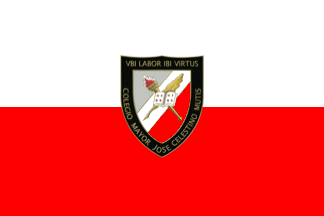
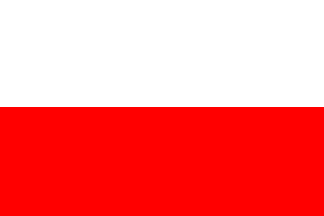 obverse and reverse by Ivan
Sache, 13 August 2020
obverse and reverse by Ivan
Sache, 13 August 2020
Based on photos
obverse,
reverse from
http://mutisschool.com/historia
and http://mutisschool.com/actividades
located by Esteban Rivera, 12 August 2020
Notice the motto "Vbi labor ibi virtus", the same as the ITC (Instituto Técnico Central). The official description of the flag is as follows: "Lleva en
sus colores el símbolo del espíritu MUTISIANO enmarcados por los principios que
inculcamos en el estudiante a través de los años de permanencia en el plantel.
El vino tinto que representa lo purpúreo de la nobleza que caracteriza al
estudiante Mutisiano formado en nuestro claustro."
Translation: "It bears in
its colors the symbol of the MUTISIAN spirit framed by the principles that we
instill in the student through the years of permanence in the campus. The red
wine that represents the purple of the nobility that characterizes the Mutisiano
student trained in our cloister. The pearl gray of steel that represents the
strength and courage that is given to the student of our school to obtain great
achievements in their personal development and that projects them to a promising
future".
Usually, the flag is the same on both sides without the coat of arms. The
allegoric description of the coat of arms is as follows: "En la cumbre de la
ciencia el saber cual lábaro triunfante se destaca, y una luz de esperanza en
cada ser se dibuja en las aulas Mutisianas. Del acero con la fuerza y la
templanza nuestro Mutis tiene un alma dibujada, de un camino que se busca en
lontananza como meta de una senda ya marcada. En tu púrpura encendido hay
nobleza. En tu fondo alabastrino mente limpia. En tu pluma de saberes gran
riqueza, y en tu antorcha el sendero que ilumina. Oh mi escudo MUTISIANO
engrandecido por las gestas del Deporte, sabio anhelo tu figura en lo alto
ennoblecido va marcando paso a paso mi sendero. Ocho letras en un libro
dibujadas en el recuerdo que se esfuma en la distancia y ese ejemplo de dos
almas veneradas dan impulso, valor, fuerza y pujanza."
Translation: At the
peak of science, knowing which triumphant laborer stands out, and a light of
hope in each being is drawn in the Mutisian classrooms. From steel with strength
and temperance our Mutis has a drawn soul, of a path that is sought in the
distance as the goal of a path already marked. In your fiery purple there is
nobility. In your background alabaster clean mind. In your pen of knowledge
great wealth, and in your torch the path that illuminates. Oh my MUTISIAN shield
enlarged by the deeds of Sport, wise I long for your figure on high, ennobled,
is marking my path step by step. Eight letters in a book drawn in the memory
that fades into the distance and that example of two revered souls give impulse,
courage, strength and strength".
Esteban Rivera, 12 August 2020
.gif) image located by Esteban
Rivera, 12 August 2020
image located by Esteban
Rivera, 12 August 2020
Source:
http://mutisschool.com/historia
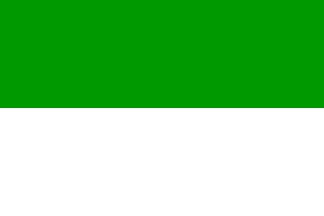 image by Ivan Sache, 07 December 2014
image by Ivan Sache, 07 December 2014
Colegio José Eusebio Caro (Colcaro) is the continuation of the Casa de
Estudio established on 17 May 1834 in Ocaña (Norte del Santander Department) by
General Francisco de Paula Santander and renamed in 1906 Liceo de San Luis
Gonzaga by José María Rojas. Colegio Provincial José Eusebio Caro was
established by Decree No. 66, adopted on 22 April 1911 by the Assembly of the
newly formed Norte del Santander Province. The institute is named for the poet
and writer José Eusebio Caro Ibañez (1817-1853), co-founder in 1849 of the
Colombian Conservative Party.
The flag of Colcaro is horizontally divided green-white.
Source:
http://centenariocolcaro.blogspot.fr/2010/10/simbolos.html - Institute's
blog
Ivan Sache, 07 December 2014
 image by Ivan Sache,
9 July 2014
image by Ivan Sache,
9 July 2014
INEM José Eusebio Caro was established in Cúcuta (Norte de Santander
Department) by Decree No. 1,962 of 20 November 1969. Classes started on 6
April 1970. Centro Miguel Müller and Escuela Ciudad Jardín were merged with
INEM José Eusebio Caro by Decree No. 896 of 30 September 2002. The
institute is named for the poet and writer José Eusebio Caro Ibañez
(1817-1853), co-founder in 1849 of the Colombian Conservative Party.
The flag of the institute is horizontally divided white-blue with a yellow
triangle placed along the hoist. White represents purity. Blue represents
the infinite horizon. Yellow represents intellectual resources.
http://www.inemcucuta.4t.com/custom3.html - Institute's website
Ivan Sache,
9 July 2014
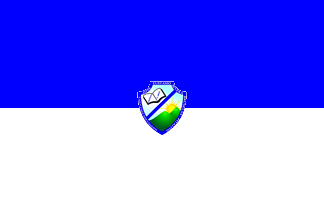 image by Ivan Sache, 12
June 2021
image by Ivan Sache, 12
June 2021
Institución Educativa Municipal José Eustasio Rivera is located in Bruselas,
Pitalito (Hulla).
The school's namesake is the writer José Eustasio Rivera
(1888-1928), author of the national epic, "La vorágine" (1924).
The flag
of IEM José Eustasio Rivera is horizontally divided king blue-white with the
school's coat of arms in the center.
The upper stripe represents wisdom and
knowledge.
The lower stripe represents the institution's values as well as
harmony and peace, which are featured of Bruselas.
The coat of arms of
IEM José Eustasio Rivera was designed in 1995 by students and professors in
social sciences.
The blue border, inscribed with the school's name,
represents the local rovers and sources. The celestial blue background, divided
by a blue diagonal stripe, again representing water resources, symbolizes wisdom
and knowledge.
The white open book, inscribed with the motto "Science and
Art", represents the disciplines taught in the school and its cultural values.
White is a symbol of purity, ethical and moral values, and peace, characteristic
of the region.
The mountains and the rising sun represents the school's
geographical context, and agricultural resources, namely coffee cultivation. The
rising sun recalls that the school is of recent formation.
https://iemjoseustasiorivera.edu.co/mision.html
School website
Photo
https://www.alcaldiapitalito.gov.co/index.php/noticias/item/5076-institucion-educativa-jose-eustasio-rivera-de-bruselas-recibio-nueva-dotacion-de-mobiliario-escolar
Ivan Sache, 12 June 2021
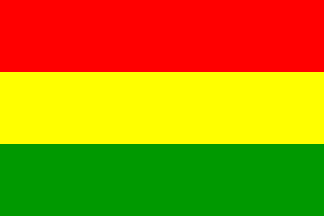 image by Ivan Sache,
5 July 2014
image by Ivan Sache,
5 July 2014
INEM José Felix de Restrepo is located in Medellín
(Antioquia Department).
The flag of the institute is horizontally divided
red-yellow-green. Red is a symbol of valiance, nobleness, intrepidity,
generosity, honor and strength. Yellow is a symbol of sovereignty and
prosperity. Green is a symbol of liberty, friendship, service and respect.
http://inemjose.edu.co/colegio/attachments/2123_Manual%20de%20Convivencia%202014.pdf
- Institute' Constitution
Ivan Sache, 5 July 2014
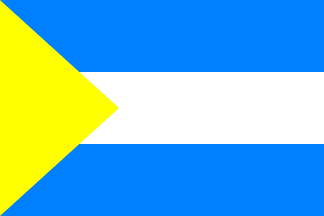 image by Ivan Sache, 9 October 2018
image by Ivan Sache, 9 October 2018
Liceo José Félix Jiménez was established in 1965 in Pasto (Nariño Department)
by Father José Félix Jiménez, as Liceo la Presentación. The school was renamed
for his founder by Resolution No. 1,463, adopted on 31 August 2007.
The
flag of Liceo José Félix Jiménez is horizontally divided blue-white-blue with a
yellow triangle placed along the hoist. Blue is a symbol of truth and knowledge,
establishing a mental balance between facts and knowledge and between people and
values. White is a symbol of peace and purity. The yellow triangle represents
positive action towards a better world centered on reality.
https://sites.google.com/site/iemjosefelix/simbolos-institucionales
School website
Ivan Sache, 9 October 2018
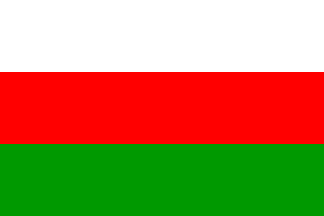 image by Ivan Sache, 12 September 2014
image by Ivan Sache, 12 September 2014
Colegio José Ignacio López was established in Sincelejo (Sucre Department) by
Departmental Resolution No. 574 of 8 November 1971. The institute is named for
His Grace José Ignacio López Umaña (1883-1974), Bishop of Garzón (1924-1942) and
Archbishop of Cartagena (1943-1974).
Source:
http://www.iejoseignaciolopez.edu.co/ - Institute's website
The flag of the institute is horizontally divided white-red-green.
Source:
http://www.iejoseignaciolopez.edu.co/contactenos/bandera - Institute's
website
Ivan Sache, 12 September 2014